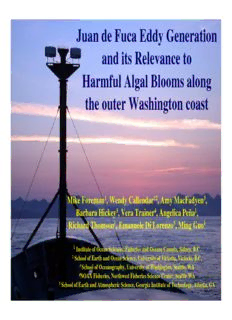
Juan de Fuca Eddy Generation and its Relevance to Harmful Algal Blooms along the outer ... PDF
Preview Juan de Fuca Eddy Generation and its Relevance to Harmful Algal Blooms along the outer ...
Juan de Fuca Eddy Generation and its Relevance to Harmful Algal Blooms along the outer Washington coast Mike Foreman1, Wendy Callendar12, Amy MacFadyen3, Barbara Hickey3, Vera Trainer4, Angelica Peña1, Richard Thomson1, Emanuele Di Lorenzo5, Ming Guo1 1 Institute of Ocean Sciences, Fisheries and Oceans Canada, Sidney, B.C. 2 School of Earth and Ocean Science, University of Victoria, Victoria, B.C. 3 School of Oceanography, University of Washington, Seattle, WA 4NOAA Fisheries, Northwest Fisheries Science Center, Seattle WA 5 School of Earth and Atmospheric Science, Georgia Institute of Technology, Atlanta, GA Acknowledgements Other participants in the ECOHAB PNW Project Related Talks 9:10 MacFadyen 11:30 Peña Outline • Background • Model details & validation • Eddy generation studies • Dynamics • Relevance to HAB development & transport • Climate change • Summary & conclusions The Region of Interest Juan de Fuca (Tully) Eddy summer upwelling feature off the (cid:122) entrance to Juan de Fuca Strait Not classical upwelling, as off WA, OR, Courtesy of Rick Thomson (cid:122) CA comprised of nutrient-rich California (cid:122) Undercurrent water (Freeland & Denman, 1982) that moves up the Juan de Fuca and Tully Canyons onto the shelf Makes the SW Vancouver Island shelf (cid:122) one of most productive fishing regions in the NE Pacific (Ware & Thomson, 2005) Sept 2005 salinity at 5m depth More recently… Eddy seems to be initiation site for toxic (cid:122) Pseudo-nitzschia that can impact clam & crab fisheries along the Washington coast (Trainer et al., 2002) ECOHAB PNW: (cid:122) multi-disciplinary project to study ecology (cid:190) & oceanography of these harmful algal blooms (HABs) Eddy physical dynamics are important for (cid:122) understanding biochemistry and transport of these HABs Regional Oceanography (cid:190) Strong tidal, estuarine, & wind- driven flows in Juan de Fuca Strait (cid:190) Estuarine flow primarily from Fraser River (cid:190) Summer upwelling winds Courtesy of Rick Thomson Freeland & Denman (1982) Hypothesis eddy closely associated with northern end of (cid:190) Tully Canyon cyclonic eddy spins up when shelf edge (cid:190) currents reverse in spring near surface, inward pressure gradient (cid:190) largely balanced by outward Coriolis force further down water column, Tully Canyon (cid:190) suppresses transverse motions leaving only inward pressure gradient pressure gradient forces up-canyon flow, (cid:190) upwelling California Undercurrent water from shelf edge We can test this hypothesis with numerical model experiments. Modeling (cid:122) ROMS = Regional Ocean Modeling System (cid:122) Objectives: (cid:190) What combination of winds, estuarine flow & tides are necessary for eddy generation? (cid:190) What are the specific dynamics? (cid:190) How do wind variations affect retention & transport? (cid:122) Model details: (cid:190) Stretched grid: 1 to 5 km (cid:190) Temperature & salinity initial conditions from summer climatology (cid:190) Average summer winds from UW MM5 atmospheric model (next slide) (cid:190) M , S , K , O tidal forcing 2 2 1 1 (cid:190) Strong TS nudging at JdF boundary to maintain estuarine flows (cid:190) Radiation &/or nudging conditions on N, S, W boundaries (cid:190) No Columbia discharge Tinis et al. (2006) compared MM5 winds with buoy data
Description: